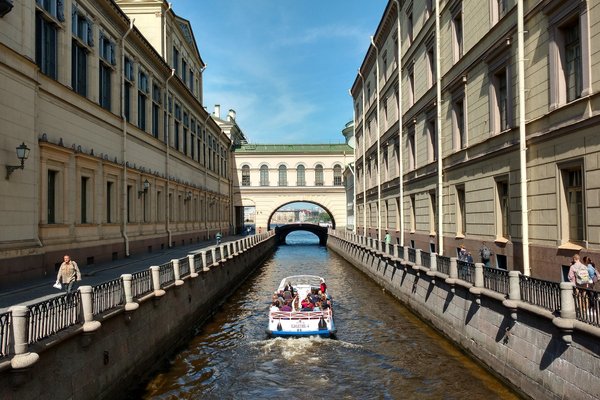Russia
St. Petersburg
The Historic Centre of Saint Petersburg and Related Groups of Monuments has a planned urban design with many baroque and neo-classical monumental buildings.
The shape of the city was developed by Peter the Great during the 18th century and exerted great influence on later city building in Russia and Finland. Its construction symbolized the opening of Russia to the Western world and a number of foreign architects worked on the great buildings. It also contains monuments related to the Bolshevik Revolution that led to the formation of the U.S.S.R.
Community Perspective: Try to visit this beautiful city in summer as it gets very cold and dark otherwise and you may even get snowed in. It can be explored well on foot. Highlights include the Hermitage, Church of the Savior on Spilled Blood, Peterhof, and the Peter-Paul fortress.
Site Info
Official Information
- Full Name
- Historic Centre of Saint Petersburg and Related Groups of Monuments (ID: 540)
- Country
- Russia
- Status
-
Inscribed 1990
Site history
History of St. Petersburg
- 1990: Inscribed
- Inscribed
- Type
- Cultural
- Criteria
- i
- ii
- iv
- vi
Links
- UNESCO
- whc.unesco.org
- Related
-
- pavlovskmuseum.ru — Pavlov Palace
- konstantinpalace.ru — Konstantin Palace
- peterhofmuseum.ru — Peterhof Palace
All Links
UNESCO.org
- whc.unesco.org — whc.unesco.org/
Related Resources
- pavlovskmuseum.ru — Pavlov Palace
- konstantinpalace.ru — Konstantin Palace
- peterhofmuseum.ru — Peterhof Palace
- eng.cathedral.ru — Saint Isaac's Cathedral
- hermitagemuseum.org — Hermitage
News Article
- May 23, 2010 itar-tass.com — Medvedev turns attentive ear to critics of Gazprom tower in St. Petersburg
- Sept. 2, 2009 bloomberg.com — St. Petersburg residents clashed with OAO Gazprom security guards and police during a public hearing over the Russian gas exporter's plan to erect Europe's tallest skyscraper
- June 13, 2008 bdonline.co.uk — Unesco ducks St Petersburg Gazprom tower heritage issue: it should be put on the "in danger" list instead of revoking WHS status
- Dec. 17, 2007 news.independent.co.uk — Plans for a 67-floor skyscraper that twists as it reaches for the sky, changing colour at different times of the day, has provoked outrage among Petersburgers, who are furious that the low-rise skyline of the city they consider to be one of the most beautiful in the world could be blighted by such a huge modern building.
Community Information
- Community Category
- Urban landscape: Post-medieval European
Travel Information
One million visitors or more
Recent Connections
-
Hunting Lodge or Castle
Great Gatchina Palace: The history of t…
-
Rose garden
Rose Pavillion at Peterhof, and also on…
-
Russian Revival architecture
Church of the Savior on Blood in Centra…
Connections of St. Petersburg
- Individual People
-
-
Visited by Alexander von Humboldt on his travels
He was in St Petersburg in May 1829 (on his expedition to Siberia) and was treated as a personal guest by the Tsar. -
King Chulalongkorn of Siam (Rama V)
(3 July) met Emperor Nicolas I at Peterhoff -
Elias Burton Holmes
1901See www.taschen.com
-
Peter the Great
1703 - orders building of St Petersburg, Peterhof Palace etc -
Heinrich Schliemann
Lived and worked there as a trader in indigo, sugar, tea and coffee (1846-1860's). Also married there -
Alexander II of Russia
"On 13 March [O.S. 1 March] 1881, Alexander II, the Emperor of Russia, was assassinated in Saint Petersburg, Russia while returning to the Winter Palace from Mikhailovsky Manège in a closed carriage." "Alexander was carried by sleigh to his study in the Winter Palace, where almost the same day twenty years earlier, he had signed the Emancipation Edict freeing the serfs. Members of the Romanov family came rushing to the scene. The dying emperor was given Communion and Last rites." (Wikipedia)See en.wikipedia.org
-
Lenin
Elizarov/Lenin Apartment Museum. Home of Lenin's sister - he lived there from April to July 1917 and it remains as a museum of his memorabilia. The Smolny Institute, seat of the Bolshevik government from Oct 1917- Mar 1918, still has a 1927 statue of Lenin outside. (The "Finland station" Lenin statue which recently had a hole blown in its backside by a bomb is outside the inscribed area!) -
Sculpted by Canova
"many of his finest works made their way to the Hermitage Museum" (wiki) -
Mao was here
"Mao Zedong boarded the night train to Leningrad. He then took a car trip across the heavily iced-over Gulf of Finland toward Kronstadt and visited the Winter Palace, the legendary cruised Avrora, and the Kirov machine factory." - The Soviet Union and Communist China, 1945-1950 Pg. 294 -
Naser ed-Din Shah
"Of the things frequently seen in Russia were the abundance of carriages in (St.) Peter(sburg), many tramways of iron in the streets, and also many beautiful dogs, large and small" -
Fyodor Dostoevsky
Dostoevsky's parents sent him to the free Nikolayev Military Engineering Institute in St. Petersburg, which he entered in January 1838. After his arrest in 1849, Dostoevsky was imprisoned in the Peter and Paul Fortress. He married Anna Grigoryevna Snitkina in Trinity Cathedral in 1867. His grave is in the Tikhvin Cemetery at the Alexander Nevsky Convent. (Wikipedia)
-
- Geography
-
-
Estuary
"The unique urban landscape of the port and capital city of Saint Petersburg, rising out of the Neva estuary where it meets the Gulf of Finland, was the greatest urban creation of the 18th century." (Official description) -
Baltic Sea
-
River deltas
Neva Delta
-
- Trivia
-
-
Dubbed as another WHS
Peterhof dubbed Russian Versailles; St Petersburg is also "Venice of the north" because of its canals & Northern Palmyra -
On Banknotes
Peter&Paul Fortress; 50 Ruble issued 1997See en.wikipedia.org
-
Modelled after
Peterhof "Russian Versailles" -
Over 100,000 inhabitants
135412 -
Google Doodles
December 7, 2014, 250th Anniversary of the Hermitage MuseumSee www.google.com
-
One million visitors or more
Hermitage: 2,812,913 visitors (2022) // 4 million (2016) -
Major City Centres
4.6 million/No inscribed area size given in UNESCO but is much bigger than 200ha -
Hosted a FIFA World Cup match
The Gazprom Arena is inside the core zone on Krestovskiy Island and hosted matches in 2018 -
Cultural sites taking up an entire island
Schlisselburg -
In Video Games
Civilization VI: Hermitage; Civilization VII: Hermitage -
On beer cans and bottles
Thornbridge Saint-Petersburg -
Serial sites with the greatest number of locations
112 separate locations -
Tobu World Square
Fountain Palace of Peter the Great -
Built or owned by French
Le Cavalier de bronze (Falconet)
-
- History
-
-
Sieges and Battles
Siege of Leningrad 1941-44 (lifted) - remains are inscribed as Green Belt of glory and Road of Life -
Queens and Empresses
Catherine Palace, built by Empress Elizabeth (1741 - 1762) and Empress Catherine II the Great (1762 - 1796). -
Summer residences
Peterhof Palace, the summer palace of Peter the Great -
Diplomatic Missions of Joseon Envoy Min Yonghwan
9 June 1896 (Lunar date: 28/4. Russian date: 28/5) Clear with slight rain later. "The area of this city is more than a hundred leagues. The population is over a million. The streets and buildings are large and magnificent. The River Neva encircles the whole city, and the imperial palace stands by the river. Each government building and all the schools are laid out in an orderly, symmetrical way. The design is excellent. It is truly an outstanding city." 14 July 1896 (Lunar date: 4/6. Russian date: 2/7) Clear weather. "At 2:00 P. M. we arrived at Peterhof after travelling 140 leagues. Two carriages from the Imperial household were already waiting for us. The ceremonial official accompanied us to the grand imperial palace. At that time the emperor was in the small imperial palace (Alexander palace).. In front of the grand imperial palace there is a water course on three sides-east, south, and north. In it there are several fountains of all kinds." 20 July 1896 (Lunar date: 10/6. Russian date 8/7) Clear weather. "At 8:00 A.M. Admiral Huosudov invited us to go to the estuary gun batteries. We left the River Neva on a steamship. This ship belongs to the Imperial Household and is very luxurious and comfortable. We travelled toward the southwest for 140 leagues and arrived at Kronstadt harbor. There were village dwellings all in a row and ships.. masts bristling like a forest. In the middle of the sea on the left and right at regular intervals were gun batteries. There were also gun emplacements on the nearby mountains, which were guarded by soldiers. There was a test-firing of several guns. Their sound rumbled and exploded like thunder. This newly founded city will expand and later become impregnably strong." 31 July 1896 (Lunar date: 21/6. Russian date: 19/7) Clear weather. "At 7:00 P.M. I went together with Planson to Kolpino (more than 30 leagues distant from here). There is a round observatory building there with four or five telescopes. The roof is covered with glass, which opens and shuts so that you can see things magnified 250 to 260 times" -
Located in a Former Capital
Russian Empire 1712-1918 -
Medici lions
Several versions, including the Lions at the Dvortsovaya pierSee en.wikipedia.org
-
Second World War
The two-and-a-half-year Siege of Leningrad caused the greatest destruction and the largest loss of life ever known in a modern city. On Hitler's direct orders the Wehrmacht looted and then destroyed most of the imperial palaces, such as ... Peterhof Palace, Ropsha, Strelna, Gatchina, and other historic landmarks located outside the city's defensive perimeter, with many art collections transported to Germany.See en.wikipedia.org
-
Been part of independent Finland (de facto)
The former Finnish municipalities mentioned below were a part of independent Finland until 1939 (de facto) (or 1940 [de jure]) when the Soviet Union occupied them. Finland occupied the areas back at the Continuation War, but Soviet Union occupied them again in 1944.
540-003c1 Fort ”Ino”, or Inon linnake in Finnish, is located at the former Finnish municipality of Uusikirkko
540-025d The park ”Dubki” is located at the former Finnish municipality of Siestarjoki (Systerbäck in Swedish, Sestroretsk in Russian). Siestarjoki or Rajajoki (Border River) was a border town between Finland and Russia from 1812 until 1940. Nowadays, the only surviving attraction in park ‘Dubki’ from the period of Peter the Great is the magnificent oak grove.
540-025e Sestroretsky Razliv is half former Finnish municipality of Siestarjoki and half part of the areas that Finland occupied at Continuation War. 540-025f Terioki (Zelenogorsk), or Terijoki in Finnish, is a former Finnish municipality. Terijoki is known especially for its sandy beaches and numerous wooden villas. It was a popular holiday destination in late 19th and early 20th centuries.
540-026 The I.Repin Estate ”The Penates” is located at the former Finnish municipality of Kuokkala (Repino in Russian). Kuokkala was also a popular holiday destination with villa communities and beaches. One of the villas at Kuokkala is the one of famous Russian painter Ilya Repin, the Penates. After the Finnish independency in 1917 Repin’s ties with Russian cultural elite broke and he wanted to integrate with Finnish painter community. Repin lived in his villa for 30 years, 13 years of which in independent Finland. He was even married with a woman of Finnish origin. Repin died in his villa in 1930 and is buried to the garden of Penates.
540-027 The Cemetery of the Village of Komarovo is located at the former Finnish municipality of Kellomäki (Komarovo in Russian). Kellomäki was known for its lively artist community. In the cemetery there are buried several well-known Russian artists, e.g. Anna Akhmatova.
540-028 Lindulovskaya Roshcha, or Lintulan lehtikuusimetsä (Lintula Larch Forest) in Finnish, is located at the former Finnish municipality of Raivola (Roshchino in Russian). Lintula Larch Forest had a major impact on the cultivation of larch throughout the world and is considered one of the most important cultivated forests in northern Europe. -
Insurrections
Assault of Winter palace by Bolsheviks in 1919; Kronstadt Rebellion Mar 1921 -
History of Aviation
David Schwarz developed his airship there as an Austrian military attaché -
Assassinations
(Yusupov Palace) Rasputin (Dec 16 1916)
-
- Architecture
-
-
Rose garden
Rose Pavillion at Peterhof, and also one at Pavlovsk Park
-
Neoclassical architecture
-
Star fort
Peter & Paul Fortress -
Moorish revival
Arab (or Moorish) Room in the Yusupov Palace -
Gold Surfaces
St Isaacs Cathedral - its "golden cupola, gilded with about 220 pounds (100 kg) of pure gold". Also - Admiralty Spire and Cathedral of SS Peter and Paul -
Baroque
Petrodvorec Palace -
Neo-Baroque
Beloselsky-Belozersky Palace 1846-8/ Stekenschnieder -
Faux marble
Peter and Paul Cathedral, Pavlovsk Palace, Jussopov Palace -
Domes
St. Isaac's Cathedral, built 1842, with a cast iron dome nearly 26 meters wide. -
Designed by Karl Friedrich Schinkel
Alexander Nevsky chapel, Peterhof -
Palladio and Palladian style
Tauride Palace, State Bank and Hermitage Theatre in Saint Petersburg, Palladian Bridge and Saint Sophia's Church in Pu?kin, Palace in Pavlovo -
Rococo
Catherine Palace and Oranienbaum -
Wooden architecture
Peter the Great's Summer Cabin -
Italian Architects outside Italy
Domenico Trezzini, Bartolomeo Rastrelli, Antonio Rinaldi, Giacomo Quarenghi, Carlo Rossi -
Russian Revival architecture
Church of the Savior on Blood in Central Saint Petersburg and Sts Peter and Paul's Cathedral in Petergof.
-
Chinoiserie
Pushkin (Tsarskoe Selo)- part of St Petersburg - has a Chinese Village and a Creaking Pagoda -
English garden
Pavlovsk Palace "Pavlovsk is well worth visiting both for the treasures in the elegant palace and for the charming, rambling park, which is one of the largest and finest English-style landscape gardens outside the UK. " (From www.saint-petersburg.com/pavlovsk/index.asp ) AND Peterhof "Catherine the Great oversaw the creation of the first landscape garden at Peterhof, the English Park, which was designed jointly by English landscaper James Meders and the great Italian architect Giacomo Quarenghi. The park was once the setting for Quarenghi's English Palace, considered one of the finest works of Russian classicism, which was later used as a guesthouse for foreign visitors, and then destroyed by artillery fire in the Second World War. "
-
- Damaged
-
-
Damaged in World War II
Ropsha Palace (still in partial ruins) -
'Threatened' by Skyscrapers
"Okhta Centre" (or Gazprom Tower)/ Architects - RMJM/396mtrs/77 floors/ St P City council has delayed its part of the finance due ot economic conditions/ Originally planned for 2016See en.wikipedia.org
-
Cultural sites damaged by fire since inscription
Trinity Cathedral, Aug 25 2006 -
'Threatened' by Dams
St. Petersburg (Northern Forts of Kronstadt) by the Saint Petersburg Dam Project.
-
- World Heritage Process
-
-
Perfect Inscriptions
1990 -
Developed since inscription
"Flood protection Facility complex" passes through the inscribed Northern forts of Kronstadt (still under construction but northern section from Kronstadt was opened in Dec 2007) -
First inscriptions
Russia: four inscriptions in 1990 (as USSR), with Historic Centre of Saint Petersburg and Related Groups of Monuments as the first recorded and with the lowest number
-
- Religion and Belief
-
-
Lavra
Alexander Nevsky Lavra (Russian Orthodox Church) -
Holy Tunic
Fragments of the Robe were held in the Sts Peter and Paul Cathedral and the Grand Church of the Winter Palace (consecrated as a Cathedral in 1763.). There is no mention of them being in either building today. -
Cathedrals
St Isaacs, St Sampson, Our Lady of Kazan, SS Peter + Paul, Smolny Cath, St Nicholas Naval Cath, Transfiguration, Trinity, St Andrews, Grand Church of the Winter Palace ( consecrated as a cathedral in 1763) -
Griffins
Two on the Bank BridgeSee www.prlib.ru
-
Museums of Atheism
Kazan Cathedral "After the Russian Revolution of 1917 the authorities closed the cathedral (January 1932). In November 1932 it reopened as the pro-Marxist "Museum of the History of Religion and Atheism". Services resumed in 1992, and four years later the cathedral was returned to the Russian Orthodox Church." (Wiki)
-
- Human Activity
-
-
Hunting Lodge or Castle
Great Gatchina Palace: The history of the palace dates back to 1765, when Catherine the Great presented this plot of land to her favorite, Count Grigory Orlov, for a hunting lodge.(...) Since Orlov's times Gatchina has also been called "The Hunting Capital of Russia," which is reflected in much of the palace's artworks. (Moscow Times)
-
Boats
Aurora (mentioned in the inscription docs) -
Mints
The Peter and Paul fortress: "Other structures inside the fortress include the still functioning mint building (constructed to Antonia Porta's designs under Emperor Paul)" -
Time Balls and Guns
At noon from the St Peter and Paul FortressSee www.timegun.org
-
Protective engineering works against flooding
A 25km long dam ("Flood Prevention Facility complex") has been under construction since 1980 (but was delayed for 15 years after the fall of the USSR and restarted in 2003). The Dam passes through the inscribed sites of Northern Forts of Kronstadt - and has indeed led to the destruction of parts of them. -
Zero Meridians
The "Pulkovo Meridian" was the base point for all geographical maps of Russia. It ran through the main hall of the Pulkovo Observatory.See www.gao.spb.ru
-
Sea Ports
-
Amber
The "Amber room" at Tsarskoye Selo. A replica since the original disappeared during WWII after being looted by the Nazis -
Museum History
Kunstkamera (1718-1734), one of the earliest buildings constructed for use as a museum (by Peter the Great, encyclopedic collection/ cabinet of curiosities)See en.wikipedia.org
-
Hermitage Museum
main buildings -
Tramways
-
Gilded Lacquer or Urushi
Lacquer Study Room with gilded lacquer at Monplaisir, part of Peterhof Palace. -
Shipyards
Kronstadt - "A significant share of the 18th century dockyard survives today, as part of the St Petersburg World Heritage Site" (Chatham Comparative Analysis) -
Cannibalism
Reports of cannibalism appeared in the winter of 1941-1942, after all birds, rats, and pets had been eaten by survivors. Hungry gangs attacked and ate people. Leningrad police even formed a special unit to combat cannibalism. This unit resulted in 260 Leningraders being found guilty of and put in prison for the crime of cannibalism (wiki)See en.wikipedia.org
-
Grand Cascade
Peterhof -
Artificial Islands
540-003b12 Fort Alexander I -- and also Tolbukhin Island - "The lighthouse is situated on a small artificial island 3 miles west of the Kotlin island.".See en.wikipedia.org
-
Reclaimed land
"the metamorphosis of an inhospitable coastal area into a superb city" (AB ev), "From 1703 to 1725, Peter the Great lifted from a landscape of marshes, peat bogs and rocks, architectural styles in stone and marble for a capital, St. Petersburg, which he wished to be the most beautiful city" (crit i OUV)
-
- Constructions
-
-
Quadriga
One above the main arch of the General staff Building in Palace Sq (https://en.wikipedia.org/wiki/General_Staff_Building_(Saint_Petersburg)) and another above the facade of the Alexandrinsky TheatreSee en.wikipedia.org
-
Theatres and Opera Houses
Hermitage Theatre -
Monumental Monoliths
The plinth of the statue of the Bronze Horseman (Peter the Great) ? known as the ?Thunder Stone?. It is thought to have weighed 1500 tonnes prior to final carving when moved the 6 miles from the quarry to a barge on the Gulf of Bothnia and on to St Petersburg in 1768-70. -
19th century shopping arcades
The Passage (1846) -
Prison
Schlisselburg -
Notable Bridges
Blue Bridge, Lions Bridge, Egyptian Bridge -
Sphinx
Egyptian Bridge -
Monumental Columns
Alexander Column - "Also known as Alexandrian Column.... is the focal point of Palace Square in Saint Petersburg, Russia. The monument was raised after the Russian victory in the war with Napoleon's France. The column is named for Emperor Alexander I of Russia, who reigned from 1801–25." -
Obelisk
Rumyantsev Obelisk: "The obelisk commemorates the victories of Count Pyotr Rumyantsev during the Russo-Turkish War between 1768 and 1774, and his service in the Russo-Turkish War of 1787–1792."See en.wikipedia.org
-
Monumental Fountains
Peterhof -
Historic Military Parade Grounds
Field of Mars (Russian: Ма́рсово по́ле, tr. Marsovo Polye) "During the reigns of Emperor Paul I and his son Alexander I, the square took on more of a martial purpose, with the construction of military monuments in the late eighteenth and early nineteenth centuries. In acknowledgement of this, and its role in hosting military reviews and parades, it was renamed the "Field of Mars" in 1805". After the Revolution it "was for a time renamed the "Victims of Revolution Square", and was sometimes called "The Square of the Graves of the Victims of the Revolution" (Wiki). It regained its earlier name in 1944. -
Canals
Kronstadt - The Peter and Catherine Canals, Ligovsky Canal -
Railways
Leningrad - Pavlovsk railway -
Eternal Flames
Monument to the Fighters of the Revolution, on the Field of Mars, in memory of those who died during the Bolshevik Revolution. (Other eternal flames in the St Petersubrg area are NOT within the boundaries e.g Piskaryovskoye Memorial Cemetery in memory of those who perished in World War II during the Siege of Leningrad or Victory Square (where there are several flames at the Monument to the Heroic Defenders of Leningrad, in commemoration of the victims and survivors of the Siege of Leningrad.) -
Cemeteries
Komarovo Cemetary - burial place for many of the Soviet intelligentsia -
Large squares
Palace Square, 50000 m2 -
Music Academies
Rimsky-Korsakov Conservatory -
Triumphal Arches
Narva Triumphal Gate, Moscow Triumphal Gate -
Historic Cinemas
"Aurora". (1913) Nevsky Prospect & "Dom Kino" / "Rodina" (1914/16) Karavannaya Ul -
Significant Follies
Chinese Village Tsarskoe SeloSee en.wikipedia.org
-
Dynastic Burial Places
Peter and Paul Cathedral - almost all the Russian Emperors and Empresses from Peter the Great to Nicholas II -
Lighthouses
Several, including the 18C Tolbukhin lighthouse located on an artificial island in the Gulf of Finland which is still in use -
Equestrian Statues
The "Bronze Horseman" of Peter I was commissioned by Catherine and stands on a pedestal known as the "Thunder Stone" which has been claimed to be the largest single stone "ever moved by man". The bronze Monument to Nicolas I in front of St Isaacs Cathedral "Unveiled on July 7th 1859, the statue was a technical wonder of its time; it spans six meters and was the first equestrian statue in the world with merely two support points (the rear hoofs of the horse) " (Wiki - http://en.wikipedia.org/wiki/Monument_to_Nicholas_I ) . The Bronze horseman also stands on just 2 legs but its tail provides further support!See en.wikipedia.org
-
Carillons
Peter and Paul Cathedral
-
- WHS on Other Lists
-
-
Creative Cities
GastronomySee www.unesco.org
-
European Garden Heritage Network
Summer Garden, St PetersburgSee www.eghn.org
-
World Monuments Watch (past)
Alexander Palace, Tsarskoje Selo (1998, 1996), Catherine Palace - Agate Pavilion, Tsarskoje Selo (1998), Chinese Palace at Oranienbaum State Museum, Lomonosov (2004, 2002, 2000), Yelagin Island Palace and Park Ensemble (1998); St. Petersburg Historic Skyline + Mendeleev Tower (2008) -
Memory of the World
Ostromir Gospel (2011) - now is in the Russian National Library in St. PetersburgSee www.unesco.org
-
The Jean-Paul-L’Allier Prize for Heritage
2019: Redevelopment of industrial cultural heritage sites and their grounds for public projects
-
- Timeline
-
-
Built in the 18th century
"the result of a vast urban project begun in 1703 under Peter the Great"
-
- Science and Technology
-
-
Historic Laboratories
Pavlov Lab -
Libraries
National Library of Russia, established in 1795 by Catherine the GreatSee en.wikipedia.org
-
Universities
State University -
Astronomy and Astrology
Pulkovo Observatory (Struve was its first director) -
Scientific Developments
Mendeleev developed the concept of the Periodic Table of Elements whilst Professor of Chemistry at St Petersburg university. The apartment, which came with the job and is part of the University, is maintained as the Mendeleev museum and contains his study and papers. It is situated in what is now named Mendeleevskaya Iniya close to the Neva across from the Admiralty
-
- Visiting conditions
-
-
Shoe covers required
In a lot of the palaces -
Strict no-photography policy inside
Catherine Palace: Amber Room
-
- WHS Names
-
-
Name changes
Changed from "Leningrad" (1991 in the real world, unclear when at Unesco list)
-
- Literature & Film
-
-
Works by Nobel Prize winning authors
Mikhail Sholokhov (1965) - And Quiet Flows the Don -
James Bond in Movies
GoldenEye (1995) -
Location for a classic movie
Oktyabr (Ten Days That Shook the World) (Eisenstein 1928) -
James Bond in books
Goldeneye
-
News
- itar-tass.com 05/23/2010
- Medvedev turns attentive ear to cr…
- bloomberg.com 09/02/2009
- St. Petersburg residents clashed w…
- bdonline.co.uk 06/13/2008
- Unesco ducks St Petersburg Gazprom…
Recent Visitors
Visitors of St. Petersburg
- Adrian Turtschi
- Afshin Iranpour
- Albert
- Alberto Rodriguez Gutierrez
- Alexander Barabanov
- Alexander Lehmann
- Alex Goh
- alicemears
- Alikander99
- Ali Zingstra
- ALS
- A. Mehmet Haksever
- Ammon Watkins
- Ana
- Ana Lozano
- anthonybonbon
- arina_soboleva
- Artsybrea
- Artur Anuszewski
- Ask Gudmundsen
- Aspasia
- Atila Ege
- AYB
- Bamse
- Bill Maurmann
- Birgitte Sørensen
- Bodil Ankerly
- bossc
- Brett Baumann
- Bropyk
- butterflybird
- ButterflyEarring
- c82wc1
- CampbellME
- Carlo Medina
- Carlo Sarion
- Caspar
- cflw
- Chalamphol Therakul
- Chantal den Haan
- chenboada
- CherylKla
- ChrisDorn
- Christer Sundberg
- Christian Wagner
- christof
- Christoph
- Christravelblog
- Cirene Moraes
- Claire Bradshaw
- Clyde
- Cobaltrage
- Corinne Vail
- Csaba Nováczky
- ctravel
- CugelVance
- czesioszpachelka
- Daniela Hohmann
- Daniel Gabi
- debatecoach
- Delphine Delaunay
- Dennis Nicklaus
- Digits
- Dimitar Krastev
- Dimitrios Polychronopoulos
- disnsam
- dmscanlan
- Don Irwin
- DouglasR
- edstar500
- Elisabeth Fransisca Situmorang
- eljx1988
- Ellen Nielsen
- Els Slots
- Emili Xaus
- Eric Lurio
- Erik Jelinek
- Ertai
- Eva Kisgyorgy
- Evgenii
- Fam39
- Fan Yibo
- fedemarch92
- Felicité
- Femke Roos
- Fernweh
- Filip Murlak
- Filippo Ubaldi
- finsbury_jo
- FK
- Fmaiolo@yahoo.com
- Frederik Dawson
- FS
- Gabor
- Gary Arndt
- g.emma_bae
- George Gdanski
- GeorgeIng61
- Gernot
- Gilles
- giloudepuertorico
- Hadrianus
- Hammeel
- Harald T.
- Harry Mitsidis
- H Beswick
- Hdwilsonau
- Hughes1920
- Iain Jackson
- Ilya Burlak
- Ingemar Eriksson
- Ivan Rucek
- Jacob Choi
- Jakubmarin
- janis
- Janos
- Jan-Willem
- Jarek Pokrzywnicki
- Javier
- Jay T
- Jean Lecaillon
- Jeanne OGrady
- Jens
- João Aender
- Jonas Hagung
- Jonas Kremer
- jonathanfr
- Jon Opol
- JoStof
- Joyce van Soest
- Juha Sjoeblom
- jxrocky
- KarenBMoore
- Kasper
- Kbecq
- Kerékgyártó
- Knut
- Krijn
- Kristin
- La Concy
- Lara Adler
- LaVale
- Lazerway
- lindaann
- Linz
- Lithobates
- lucyannesmith
- Ludvan
- Luis Filipe Gaspar
- Luj3904
- Maciej Gil
- Malgorzata Kopczynska
- manman2411
- Marcobrey
- Mariam
- Marie
- Marinemajor
- Martin
- Martina Rúčková
- Marton Kemeny
- maryhattie
- Matejicek
- Matthewsharris
- MaxHeAnouBen
- MaYumin
- Mia esguerra
- Michaela0705
- MichaelH
- Michael Novins
- michaelsballard
- Mikko
- Mikko Syrjä
- Milan Jirasek
- Miloš Tašković
- MMM
- Monica66
- Monica Tasciotti
- montgomw
- Morodhi
- MWaters66
- MystRivenExile
- Naim Y
- nan
- natlefebvre@hotmail.
- Niall Sclater
- Nick M
- nicku
- Nihal Ege
- Olli-Pekka Turunen
- Onkrad
- opperpco3
- Patrik
- Patrik_globe
- PeterH
- Petri Jurescu
- Petteri
- Philipp Leu
- phillipmeng
- Pincze
- Pink Bunny
- Piotr Wasil
- Potsdamer
- pressdm
- puessergio
- Purrfect
- Rahelka
- Randi Thomsen
- Reiseblitz
- Remski
- Reza
- Rick Ohm
- rivr
- Roccobot
- Roger Enarsson
- Roger Ourset
- Roman Bruehwiler
- Sandmann15
- Sclowitz
- serghei.belous
- Sergio Arjona
- sibariam
- Sijia
- Slavi
- Solivagant
- Squiffy
- Ssong.x
- Stan
- StaziG
- Sutul
- Szabolcs Mosonyi
- Szucs Tamas
- Tamara Ratz
- Taotao Chen
- Tarquinio_Superbo
- Tatiana Nikulnikova
- Tevity
- Thomas Buechler
- Thomas van der Walt
- Tikhon Puliaev
- TimPick
- Tinamu
- Tom Flaten
- tommasorossotti
- Tony H.
- Toxicologist
- Traveling Girl
- triath
- Truls Brekke
- Tsunami
- UncleSlavi
- valentinaui
- Van Hung
- Vernon Prieto
- viktor_balandin
- voyager
- Walter
- wantrain.
- Waxwing
- Westwards
- WILLIAM RICH
- Wimmy
- Wojciech Fedoruk
- Wo_ko
- Xiquinho Silva
- Yang Chengyu
- Yevhen Ivanovych
- Yongcheng Liu
- ZCTLife
- Zirconium796
- Zizmondka
- Zoë Sheng
- Zsuzsanna Forray
- Александар Стојиљковић
Community Reviews
Show full reviews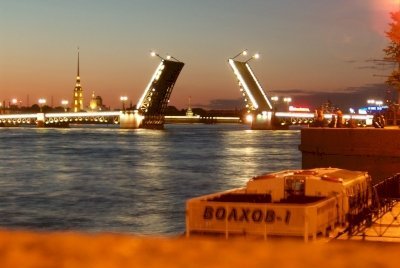
Sankt Petersburg is a great city, and I have been to two times: as 3-days visit of a friend in 1999, and a conference trip for a week in 2008. Besides, we went also to Peterhof, which is (as many other places) the part of this WHS. Well, St. Petersburg is built in European classicist style, but it has rather non-European size: even walking along the Nevsky Avenue takes quite a long time. Thus, one day visit is really not enough, and a week would be a minimum. Another aspect is the setting of St. Petersburg, where river Neva, its canals and bridges are the added value and make the city really outstanding. We joined the boat trip, which was pleasant but rather chilly experience. I would recommend going to St. Petersburg in June during so called white nights (PHOTO taken at midnight!).
As regards the monuments, I enjoyed my visit to Hermitage museum, but I cannot say it is related to the OUV of the site. Peterhof is also very nice and worth of visit, but I had a feeling that it is a tourist trap! It is possible to go there by train or by ferry from the city center.
I grew up in communists times of former Czechoslovakia, and I put it into the context during my visits of St. Petersburg. First, all the style and decorations in the hotel I was accommodated in 2008 - it remind me my childhood! Further, I realize how …
Keep reading 0 comments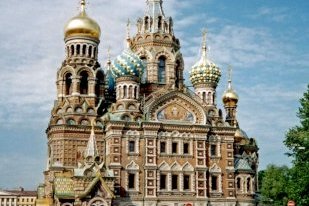
The Historic Centre of Saint Petersburg and Related Groups of Monuments is easily my favorite of all World Heritage Sites I've seen in Russia. This 300-year-old city was wrested from swamps to become a capital, much like a city started later that century half a world away and much closer to home for me. Saint Petersburg is a feast for travelers, replete with history, culture, and architecture.
Saint Petersburg was a dream made manifest by Peter the Great, who envisioned a great European city built upon the Neva River delta looking westward. This city is a joy to explore on foot, from the broad avenue of Nevsky Prospekt to the grand square in front of the Winter Palace, home to the renowned Hermitage Museum; from Vasilievsky Island to the Peter and Paul Fortress; from St. Isaac's Cathedral and the Bronze Horseman statue, commemorating famed poet Alexander Pushkin's ode to the city founder, to the Church of the Saviour on Spilled Blood, built atop the site where assassins finally succeeded in killing Tsar Alexander II, a tsar who sought change too fast for some, but too slow for others. Change and revolution are common themes to Saint Petersburg. Palace Square may hold a column celebrating Russia's defeat of the French during Napoleon's unsuccessful 19th century invasion, but it was the site of significant scenes of internal revolt, such as Bloody Sunday in 1905, when demonstrators were fired upon by Tsar Nicholas II's guards, and the October Revolution in 1917, when …
Keep reading 0 comments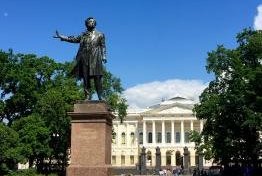
UNique - 7/10
The second capital of Russia could not be more different from the official one. The commercial gloss and modernity of Moscow gives way to the historic tarnish and culture of Saint Petersburg. This is not to say that the city is not impressive or beautiful, quite the opposite, as the lack of a gleam allows for a certain charm and cosiness which money can't always provide. Despite having been designed as the imperial city with its many palaces, squares and avenues, Saint Petersburg is replete with a variety of lesser-known communal places, hidden in the courtyards, narrow alleyways and behind the deceptive storefronts.
ESsential - 8/10
Saint Petersburg is paramount to the development of the Russian history. The seat of Peter and Catherine (both the Greats, but each in their own individual way), the starting point of the Bolshevik revolution, the site of the most brutal siege during the Second World War, the city is a treasure trove of historical and cultural artifacts, as each new turn reveals a residence of a famous writer or a beautiful building or a shady waterway. There are simply too many places of interest to list them all, and one simply has to allow themselves time to comprehensively experience the city.
COst-effective - 4/10
Chances are that if time is not exactly a limit on your trip to Saint Petersburg, then the money will soon become. Saint Petersburg is not a cheap city to experience with accommodations, food and entrances to …
Keep reading 0 comments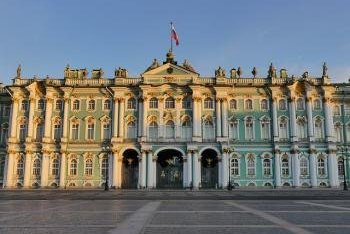
I visited Saint Petersburg for 4 days in September 2017. Having visited Moscow last year it was quite easy for me to compare both cities and both are interesting cities to visit. Both cities are in my top 200 WHS and they didn't disappoint.
It's easier to cover the historic centre of Saint Petersburg on foot and overall I felt it has a much more European feel with several churches, palaces, monasteries and cathedrals with European architecture and just a handful of onion-domed ones.
The baroque exterior of the hermitage/winter palace (photo) is as striking as it's never-ending interior and its location in the palace square and on the Neva river bank is exquisite. The canal, fairway and drawbridge boat tour is a very pleasant way to explore the historic centre and beyond.
A stroll to the Peter and Paul Fortress (incredible drone or Google Earth view) is a must and apart from the panoramic view of the Neva river and overall lack of high-rise buildings, here you will find the UNESCO inscription plaque. Vasilievsky Island is the maritime heart of the city.
The exterior of the Church of the Savior on Spilled Blood is less colourful and extravagant than St Basil's Cathedral in Moscow but its mosaic interior more than make up for this.
On separate half day bus/ferry trips I also visited the Peterhof Palace and Gardens often referred to as the Russian Versailles. My favourite highlights here were the Portrait Room and the lovely fountains with golden …
Keep reading 0 comments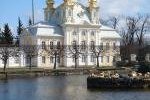
Every time I met and talked to Russians, they always praised the beauty of St. Petersburg, and that really made me wanted to see this city which was once the capital of Russian Empire. In the late evening, by the long-distance bus from Novgorod, the city of St. Petersburg welcomed me with heavy snow, after managed to take subway to city center, I still had to struck at the subway station entrance for two hours because it was almost impossible to go and find my hotel, so my first day in St. Petersburg was totally white. However, in the next day morning all snow had gone, I decided to walk to the famous Hermitage. After walked through the ceremonial arch gate, the vast winter palace square was absolutely breathtaking. After seeing gorgeous collections of Hermitage, and its equally impressive interior design, I continued my trip to Saint Isaac Cathedral to see its imposing golden dome and then Peter and Paul Fortress which I was impressed with the scenery of the city from the fortress wall, before back to Church of the Savior of Blood which was the only Russian architecture in this very European town.
The next day I went to Peterhof Palace and Katherine Palace, there two palaces are located outside the city; I need to take train and bus to reach both places. The two palaces were unbelievable with their lavish decoration which easily made all European palaces in shame. I never saw too many …
Keep reading 0 comments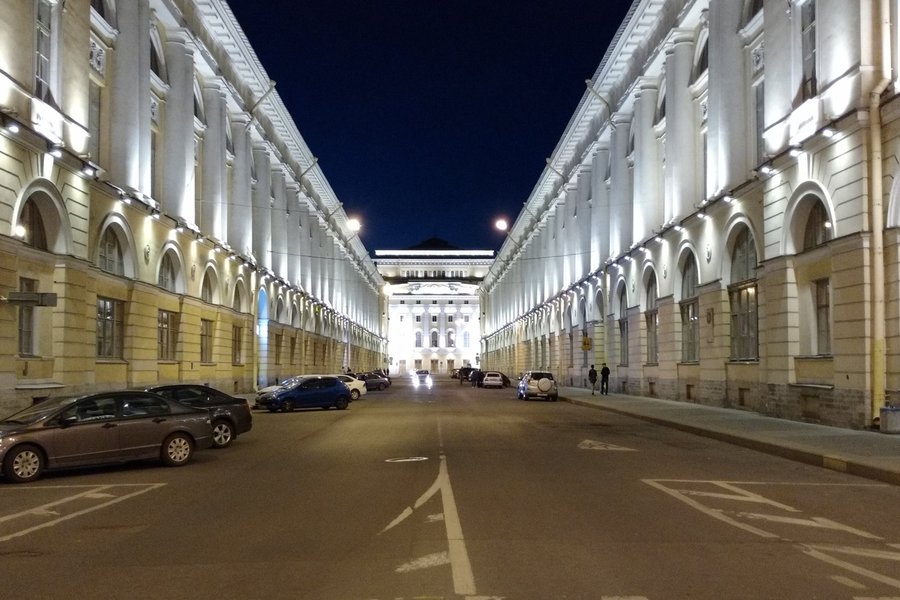
We enjoyed two days in S. Petersburg and wished we had more time. The museums have already been mentioned by other reviews we heartily agree with the positive comments about the Hermitage. We had a chance to travel by subway, which is a world all by itself, just don't try to take photos, the police do not allow it. We also visited the Kuznechny Market which was really fun. The vendors try to sell piles of unusual things and foods we had no name for. It was difficult to get rubles because there are few places to exchange currency. One of the most interesting places we saw was the Church of Our Savior on the Spilled Blood just a block off the Nevsky Prospekt. There is a great open air market on the square behind the cathedral where you can buy Russian "stuff". Just be aware that what looks like traditional Russian crafts are most likely mass produced someplace else. A walk along the Nevsky Prospekt was really fun. You will see the great train station, Kazan Cathedral, and other grand buildings. Our favorite thing aside from the museums was the canal boat ride through the city and along the river. We were warned not to get off the main streets as it was not safe for tourists and that people had no time for tourists. Our experience was that people were eager to try out their English and were helpful and friendly.
Keep reading 0 comments
I agree that The Hermitage is one of the best museums in the world. If you are visiting St. Petersburg, put aside one day to visit it. On my last day in the city (then Leningrad), which was also my last day in the country, I got lost with 2 friends from my group. We were in a panic, as the rest of our group was waiting for us at our hotel, preparing to leave for the airport. I will never forget that a young Russian man helped us get back on the right bus back to our hotel. We were so grateful that we tried to offer him some money but he refused and was rather amused by how appreciative we were. We barely made it back to the hotel on time!
Keep reading 0 comments
The town centre is a vison fulfilled by Tsar Peter. Sweden had to be cleared out from the north shore of Neva and then all rich people of Russia had to build a palace there in order to stay in the upper class. From nothing there, in the borderline between Russia and Sweden 1703, 100 years later it was a magnificent town, and continued to grow until 1917. Luckily, there is not much Soviet architecture present i centre. Not
The Neva is about 500 m wide and that sets the size of everything. I did not rent a cycle but that could be a good idea if you want to come out from the centre for a while.
Don't miss the Heremitage, Peterhof, Peter-Paul fortress and the artillery museum.
The canal boats gives nice wievs but it seems to be hard to find someone giving service in other languages than Russian. The hard problem to find service in other language than Russian is a general problem.
If you are in to military history, try to get out to Kronstadt which now can be visited by foreigners.
Be there in the summer! The streets does not seem to have lights except in the very centre. It is dark in the winter but lovely in the summer. The white nights are really existing.
Keep reading 0 comments
I have been living for two years there. Physically it is cold, and true - in a way also psychologically. But I learned to love this city -its enormous classicism ensemble, comparatively low ornate houses located along wide streets and channels. Huge, unbelievably rich museums - if you are fed up by art - visit the Zoological museum or the incredibly rich and ornate geological museum at Gornij Institut. Still many people there posess the specific intelligence, enlightement of this city - but for the bypasser from the very different West this may be invisible. And these enlightened people unfortunately do not dominate the streets of this city...
Keep reading 0 comments
